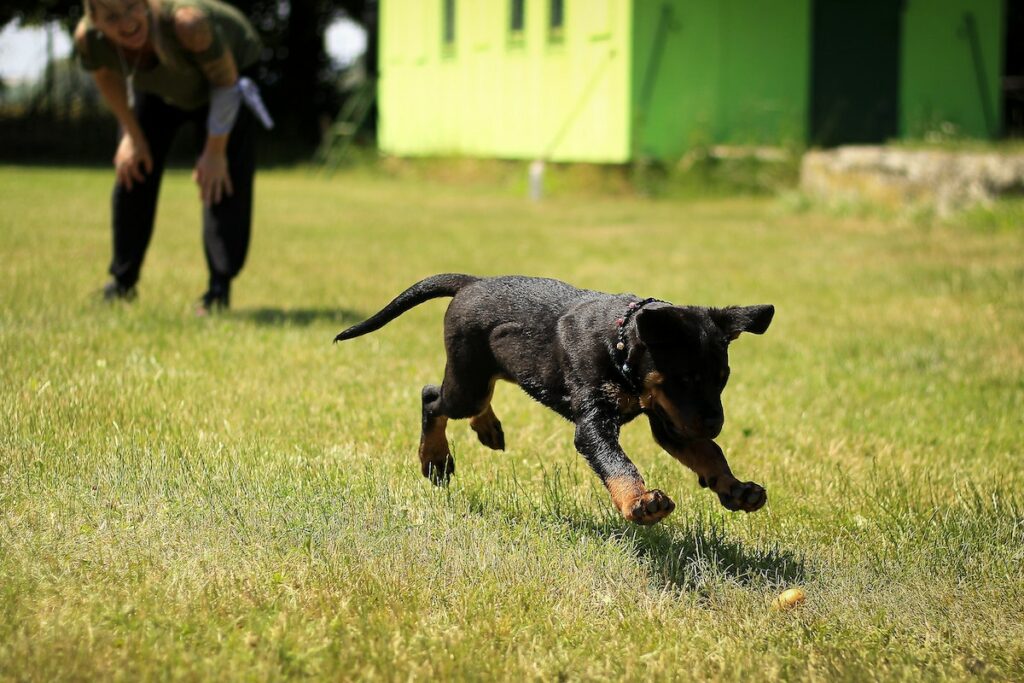Crate Training a Puppy in The UK: The Ultimate Guide
If you’re a new puppy owner in the UK, you’ll know that crate training is an essential part of creating a happy and comfortable home for your pup. Not only can it be used as a tool to manage behaviour, but it also provides security and familiarity during the transition from their previous home to their new one. This article will provide you with all the information you need to get started on crate training your pup in no time!
Crate training has been proven to help puppies feel secure and safe while allowing them the freedom to explore and express themselves within their own space. It can help with housebreaking by providing an area where they can go when they need some privacy, as well as establishing boundaries when needed. In addition, crate training helps build confidence and trust in both you and your pup, allowing them to feel more comfortable in their environment. Being able to understand each other’s needs results in better communication between both of you.
When done correctly, crate training is a highly effective way of teaching your puppy how to behave appropriately while also providing them with a place of safety. With this article, we’ll be discussing why crate training is beneficial for puppy owners in the UK, as well as providing step-by-step instructions on how to introduce them into their new home successfully. We’ll also cover what materials are best for setting up their crate and offer advice on troubleshooting any challenges that may arise during the process. So whether you’ve just got a new family member or have had yours for some time now, this article is perfect for those looking for guidance on understanding their pup’s needs through crate training.
Crate Training a Puppy in the UK: Why it’s Important
Crate training is a vital part of owning and raising a puppy in the United Kingdom.
Creates a Safe Environment
It helps to create a safe, consistent environment that can help your pup learn good behaviour while also keeping them safe and secure while they’re unsupervised.
Limits Damage
Crate training can help to limit the amount of destruction that puppies may cause when left unsupervised, as well as help them to become potty-trained more quickly.
Reduces Anxiety
Crate training also helps to reduce anxiety and stress, as puppies feel more secure when they have an enclosed space to retreat to when overwhelmed. This can make them less likely to bark or chew excessively out of fear or boredom.
Learn Good Habits
Finally, crate training can help your pup learn good habits, such as not jumping up on visitors or furniture, which can be important for developing healthy relationships with people and pets.
How to Crate Train Your Puppy in the UK
Crate training your puppy is relatively simple but should be done with patience and consistency.
Before you begin, here are a few tips that you should be aware of:
1. Start Early:
It is important to start crate training your puppy as soon as possible – ideally, as soon as they come home. This will give them time to settle into their new routine and become familiar with the crate. Make sure that the crate is comfortable and inviting, and start by introducing it gradually, keeping treats on hand to positively reinforce the experience.
2. Establish Routines:
Puppies thrive on routines, so introduce a regular schedule of feeding and toileting in order to create consistency for your pet. Keeping this routine consistent will also help you potty train your pup faster, as they will learn when it is okay for them to go outside and use the toilet.
3. Use Positive Reinforcement:
When training your puppy, be sure to reward good behaviour with treats or verbal praise when they go in their crate willingly or stay inside it while you are away from the house. Never scold or punish your pup if they make mistakes. This can have a negative impact on their confidence and slow down their learning process. Instead, focus on rewarding positive behaviour in order to encourage more of it in the future.
4. Make Crate Time Fun:
You can also make crate time more enjoyable by providing toys or chews that your puppy can play with while they’re inside it. This will keep them occupied and prevent them from feeling bored or stressed out while alone in their crate for long periods of time. Additionally, if you are able to take your pup outdoors during the day or let them join family activities around the house. Then this will help reduce any feelings of isolation that could arise from spending too much time in their crate throughout the day.
5. Limit Crate Time:
It’s also important to remember that puppies need lots of exercise and stimulation throughout the day. So try to limit how much time they spend inside their crates each day. No more than 4-6 hours at a time, depending on their age and energy levels. Ensure that they have plenty of opportunities for physical activity throughout the day too!
6. Supervise When Needed:
If you are having difficulty getting your pup used to his/her new crate. Then be sure to supervise closely when leaving them alone inside it until they become more comfortable being there on their own terms. You may even want to consider using a baby gate near their crate if needed. This can be useful for keeping an eye on what they’re up to while still allowing them some level of freedom within a contained area (e.g., living room).
Steps for Crate Training
Preparing for Crate Training:
• Make sure that the crate is comfortable and just big enough for your puppy to stand up and turn around. A too-large crate will allow them to ‘potty’ in one corner, negating the purpose of the crate.
• Add treats or toys to make it a pleasant experience for the puppy.
• Place the crate in a well-trafficked area of your home. So that it’s not solitary but isn’t too noisy either. This way, your pup will get used to having people around while still feeling safe.
• Try leaving doors open when you’re away so they can go in and out as they please. This will help them become accustomed to the idea of being inside it.
Introducing Your Puppy to Their New Crate:
• Start by feeding your puppy inside their new home, making sure that there are no distractions nearby and plenty of treats so that mealtime is associated with positive feelings about the crate.
• Once they are comfortable with eating inside, try introducing a toy or chew toy so that your pup enjoys being in their space even more!
• If they are getting anxious or uncomfortable, remove them from their space immediately and move on to something else until they calm down again.
• With each positive experience in the crate, reward your pup with praises and treats, so they come to associate this area with all good things!
• Gradually increase the amount of time spent inside. If possible, take breaks every few minutes, as puppies have short attention spans and need frequent stimulation.
Getting Them Used to Spend Time Inside:
• Once your pup is settled in their space during meal times and playtime. Begin closing the door for short periods at a time, no longer than 10 minutes initially. Make sure you stay close by. You can talk to them through an open window or door if needed. So that they don’t feel abandoned or scared.
• As time passes, gradually increase this duration (no more than 30 minutes at first). Whilst also increasing comfort by lining their bedding with blankets or cushions. Making sure to keep these same items clean since puppies tend to urinate often!
• Speak calmly when putting them into their crate. Using phrases like ‘Go to sleep now’. This will help create positive associations between words and feelings associated with going into it without fear or anxiety.
Nighttime Training:
• To ensure successful night-time training, ensure all activities are done before going into their crate. Such as playing fetch outside, taking a walk etc. This way, they won’t be too energised when asked to settle down for bedtime.
• If possible, feed dinner at least an hour before bedtime. This helps prevent any accidents due to fullness while sleeping. Then offer one last potty break outdoors prior to settling down for 8-10 hours (or however long the night lasts).
• Some puppies may whine or bark during nighttime hours. Try not to give any attention until morning but instead ignore these disturbances until morning comes; remember, consistency is key!
7 . Maintain Cleanliness:
Be sure to regularly clean out your dog’s crate using warm water and pet-safe cleaning products. Not only does this keep unpleasant odours away, but it also helps reduce any potential risks associated with bacteria-contaminated surfaces. Which could irritate sensitive skin or cause infection in puppies who don’t yet have all their vaccinations completed yet!
How Long Does Crate Training Take
Once you have established regular entry into the crate (ideally around 30 minutes per session). Gradually increase the amount of time they spend there. Start off by leaving them alone while they’re in there for short periods (around 10 minutes). Then gradually increase this time until they reach crating times of around 3 hours per day by 11/12 weeks old (or night at 8 weeks old).
Finally, remember not to leave puppies under 16 weeks alone for longer than 2 hours at any given time. If necessary, build up slowly over several days rather than rushing into long crating times all at once. With consistent practice over several weeks (and occasional treats!). Most puppies should eventually come to enjoy spending time in their den. Where they can relax away from distractions and potential dangers.
Final Thoughts on Crate Training Puppies in the UK
Crate training a puppy in the UK is a great way to ensure your pup’s safety and comfort. It can also help with potty training as well as reducing any potential accidents inside the house. With patience, consistency, and lots of treats, crate training should become an enjoyable experience for both you and your pup! Good luck!
If you have a new puppy, it’s important to insure them as soon as possible. Puppy insurance will help cover the costs of any unexpected accidents or illnesses your pup may experience. Contact furrr today to find out more and get a policy for your new furry friend!










